Get in Touch
Email Address
hello@creativitek.com
Phone Number
+61 423 493 386
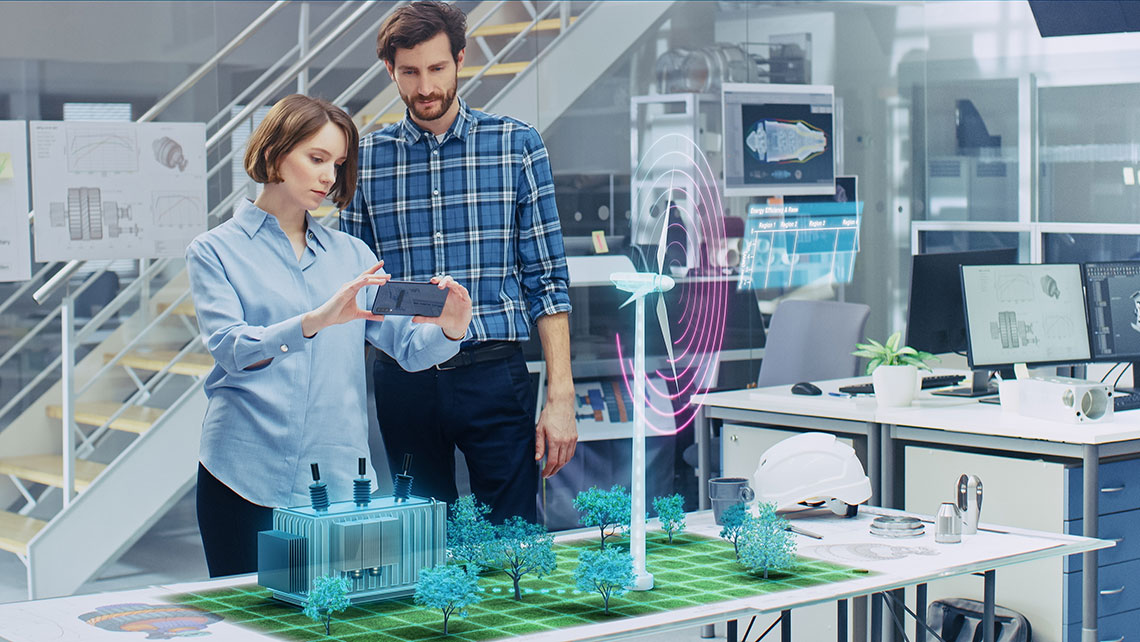
By Dr Naser Zamani
Introduction
Smart cities integrate intelligent planning, innovative services, and advanced technology to enhance community connectivity and liveability. Utilising technologies like sensors, the Internet of Things (IoT), extended reality technologies, and robust connectivity infrastructure, smart cities prioritise a citizen-centric approach to meet diverse resident needs. With a focus on connectivity and liveability, these cities strive to create environments that foster vibrant communities and seamless interactions among residents.
Mobile Augmented Reality (AR) as a catalyst for smart cities
Augmented Reality is a technology that overlays digital information, including 3D models, data, videos, images, sounds, and more, onto the real-world environment. It enhances the user's perception and interaction with their surroundings by seamlessly blending digital content with the physical world through devices like smartphones or AR glasses. Mobile AR emerges as a dynamic force shaping smart cities, transforming how people engage with urban environments. With mobile AR, every smartphone or tablet user becomes a potential AR user, providing broad access to this transformative technology and contributing to the city's goal of enhancing connectivity and liveability.
Diverse Applications of AR for Smart Cities
1. Participatory planning and design
Augmented Reality plays a transformative role in participatory urban planning. By integrating AR into proposed urban designs, councils empower residents to virtually step into the future of their city. Through AR applications, individuals can explore upcoming developments in three-dimensional detail, visualising how new infrastructure, buildings, and public spaces will integrate with the existing environment. This immersive experience fosters a deeper understanding and connection to the proposed changes, allowing residents to provide more insightful and informed feedback during community engagement sessions. The result is a collaborative and inclusive urban planning process that reflects the diverse needs and preferences of the community. Utilising augmented reality for participatory urban planning enhances the equity and sustainability of cities.
Click HERE to watch a video showcasing how the City of Johannesburg used Minecraft and augmented reality to engage residents in designing their city. Another noteworthy project in the City of Charlotte by University of North Carolina at Charlotte researchers utilises augmented reality technology for scenario planning. Residents can compare different place types, forecast the implications of choices, and express their preferences. This project is still under development. Click HERE to watch a video.
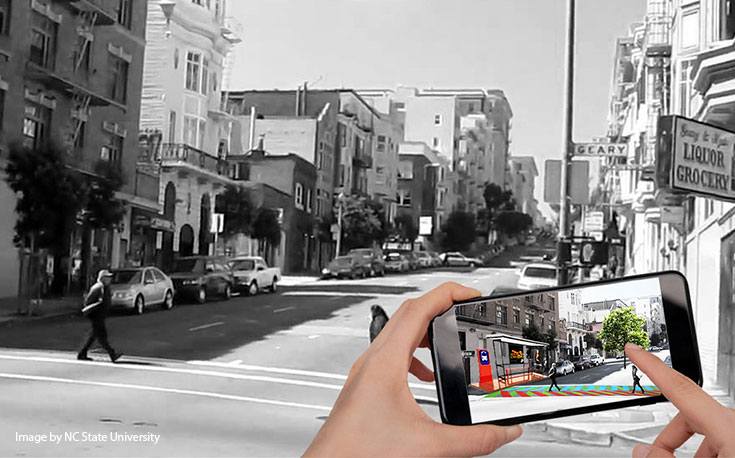
2. Community engagement, education, and communications
AR serves as a dynamic tool for community engagement and education, creating interactive touchpoints throughout the city. AR information points strategically placed in public spaces offer real-time updates, event schedules, and important announcements. Residents and visitors can simply use their smartphones to scan these points, accessing a wealth of information that enriches their understanding of local events, services, and educational resources. This instant access to relevant content enhances community engagement by providing timely and context-specific information. The immersive, engaging, and gamified experience motivates individuals to participate actively and share feedback. This innovative approach not only captivates audiences but also promotes continuous learning and exploration within the community.
Augmented reality is a powerful tool for raising awareness and educating the community. Click HERE to explore CreativiTek's award-winning project, supported by the Australian government, using mobile augmented reality to involve parents and educate children about road safety. And click HERE to watch a video showcasing how AR has been used to engage the community as part of an upgrade to water infrastructure in Brisbane’s Queen Street Mall.
AR human holograms are another use case for engaging citizens and making city services more accessible. Multilingual virtual assistants have the potential to bridge the language gaps in council-offered services. Artificial intelligence-powered human holograms can understand and speak different languages, making the city much less monolingual. Holograms can be human-like or avatar characters. Access the related video through this LINK.
3. Culture, heritage, tourism, and destination marketing
AR transforms cultural experiences, tourism, and heritage appreciation by seamlessly blending the physical and digital worlds, and providing phygital and shareable experiences. Heritage tours become dynamic journeys as historical landmarks reveal hidden stories and visuals through AR applications. Art installations take on new dimensions as AR enhances the viewer's perception, providing context, narratives, and even interactive elements. The integration of AR into cultural initiatives ensures that residents and tourists alike engage with the city's rich history and cultural fabric in a compelling and memorable way.
Click HERE to read how Bland Shire worked with CreativiTek to showcase the history of the Gold Mine industry in their region and engage and educate tourists in an innovative way using immersive augmented reality experiences. Social media AR advertisements can be used to promote places or festivals. Follow this LINK to explore the AR experiences developed by CreativiTek for the city of Geelong. As part of a range of immersive experiences, we created a digital replica of their floating Christmas tree and developed an AR face filter (Meta AR ads), prompting users on Facebook and Instagram to capture and share photos, transforming them into ambassadors for city tourism.
Watch how Dublin City Council has used augmented reality portals, narrated storytelling, human holograms, AR landmarks, and 3D maps to bring back history, engage residents and tourists, and help them make the most of their time in Dublin by clicking HERE. Watch how Stirling Council has used immersive AR experiences to allow people to explore the city in a unique and exciting way through their smartphone screen by clicking HERE. Virtual signs will respond to users’ needs, Stirling’s rich history and heritage will be brought to life and interactive games will unlock rewards and incentives. They have also used AR wayfinding and 3D maps, landmarks, and face filters to enrich the city experience.
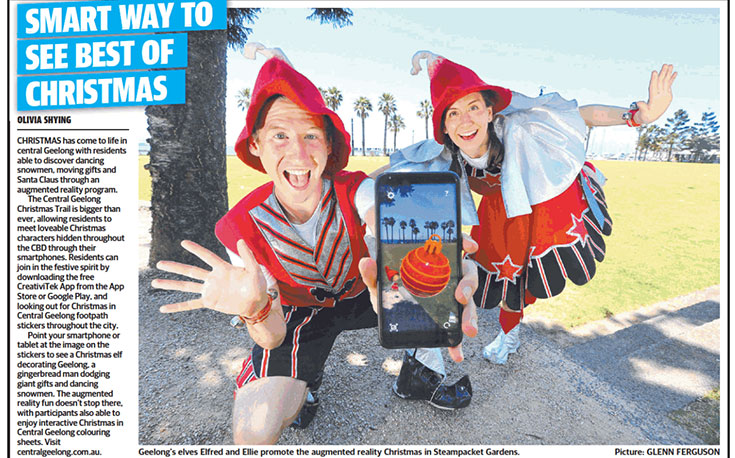
4. Economic development and local business support
In the realm of economic development, AR has become a powerful ally for local businesses. AR applications serve as virtual gateways, providing users with information about nearby businesses, promotions, and exclusive offers. The creation of virtual storefronts allows businesses to extend their presence beyond physical locations, showcasing products and services to a broader audience. This digital dimension not only enhances the visibility of local enterprises but also encourages residents to explore and support businesses in their community. By strategically deploying AR as a tool for economic development, councils can not only stimulate local commerce but also foster a sense of community pride. Through engaging, gamified experiences, AR contributes to increased foot traffic, longer stays in business areas, and higher local sales, ultimately enhancing overall economic development and the vitality of neighbourhood business districts.
Click HERE to read about a case study where the City of Norwood Payneham & St Peters partnered with CreativiTek to use augmented reality to create a festive season during the COVID-19 period and boost foot traffic, contributing to economic development goals. Google's ARCore collaborated with the Singapore Tourism Board to develop an immersive, augmented reality guided tour. Join Merli, Singapore's tourism mascot, as you explore the city's iconic landmarks. From discovering the best local hawker food to uncovering history through scenes from the past, the app guides travelers to hidden spots and businesses in the city. View the YouTube video HERE.
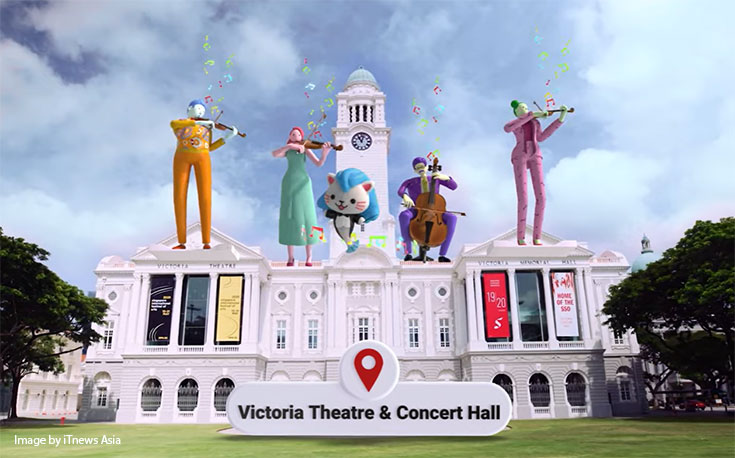
5. Festivals, placemaking, and city experiences
Festivals, (digital) placemaking initiatives, and overall city experiences are elevated through the integration of AR. AR maps guide festival-goers seamlessly through event venues, providing real-time updates on performances, activities, and amenities. Art installations and placemaking projects take on new life as AR overlays introduce interactive elements, turning static structures into dynamic, engaging focal points. The city itself becomes a canvas for immersive experiences, where AR transforms public spaces into vibrant, interactive environments. This integration not only enhances the enjoyment of festivals and cityscapes but also fosters a sense of community, as residents and visitors share in the excitement of augmented city experiences.
Click HERE and HERE to read how Maribyrnong City Council partnered with CreativiTek for the Christmas festival, digital placemaking, and city experiences. Multiple AR experiences, including augmented reality murals, trails, installations, and augmented reality colouring pages, were created to help the council get the results they planned.
With AR, cities can creatively host concerts and art exhibitions, bringing innovative experiences to their residents. View the video HERE to witness how an immersive performance by Gorillaz captivated fans, gathering them in New York City’s Times Square to witness a larger-than-life AR presentation.
6. Sustainability initiatives
AR becomes a catalyst for sustainability initiatives by creating awareness and encouraging environmentally conscious behaviour. Eco-tours powered by AR offer residents insights into green initiatives, sustainable practices, and environmental landmarks within the city. Residents can use AR applications to virtually plant trees or participate in eco-friendly challenges, promoting a sense of responsibility and engagement in sustainable practices. Virtual green spaces overlaid onto urban landscapes through AR serve as a reminder of the importance of nature within the city. By leveraging AR for sustainability, councils can inspire a collective commitment to environmental stewardship, fostering a greener and more eco-conscious community.
The Canadian Beverage Container Recycling Association used the Recycling Starts Here contest app as an augmented reality experience to encourage Manitobans to recycle empty beverage containers. To read more click HERE.
In sustainable urban planning, ensuring accessible and efficient transportation options is crucial for reducing environmental impact, improving air quality, promoting public health, and enhancing overall livability. The City of Philadelphia has partnered with MIT Media Lab researchers to create augmented reality tools that will make transportation more accessible for people with disabilities in Philadelphia. Stay tuned for updates on this ongoing project.
Click HERE to watch a YouTube video showing how The Coal Loader Centre for Sustainability (North Sydney Council) uses AR to educate visitors about sustainability concepts and native animals. The YouTube video HERE showcases how AR can be used to increase awareness and educate the community on how to make greener and more sustainable cities here.
Councils frequently rely on print materials for various purposes, including citizen communications. Augmented reality offers a sustainable solution to reduce paper usage while enhancing information delivery (less paper, more information). AR helps turn static print materials into interactive, engaging, and playful communication channels. Click HERE to watch a video showcasing how CreativiTek brought printed posters and stickers to life using 2D and 3D animations. Watch another YouTube video of an augmented reality magazine by clicking HERE.
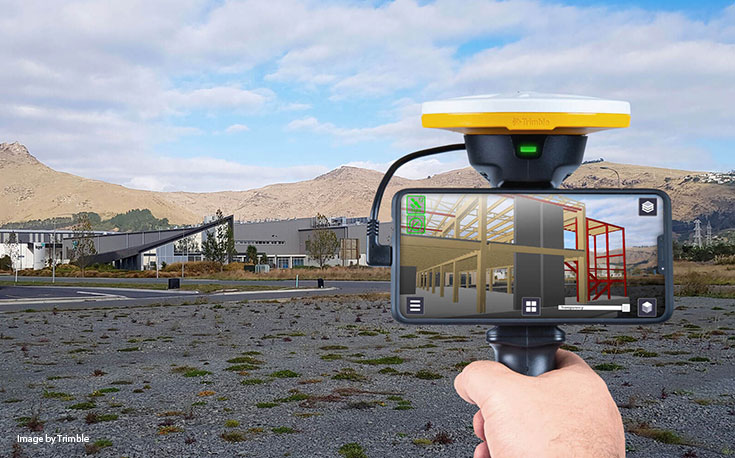
7. Smart project and asset management
Incorporating AR into smart project management, as well as asset and resource management, revolutionises the approach councils take to oversee and maintain city infrastructure. AR applications empower maintenance teams by providing real-time overlays of asset conditions, facilitating efficient inspections and repairs. This streamlined approach to asset management ensures that city infrastructure remains in optimal condition, minimising downtime and reducing overall maintenance costs. In the realm of resource management, AR facilitates real-time monitoring and visualisation of critical resources such as water and energy consumption. Data-driven insights derived from AR applications empower councils to make informed decisions, optimise resource allocation, and contribute to the overall sustainability and resilience of the city. AR is a powerful tool for visualising data. Digital twins with real-time data can be visualised in an immersive way to help make smart decisions.
Click HERE to watch a YouTube video showing how AR technology can be used to visualise data on-site, view utilities, connect to field crew, review surveys, compare design versus as built, check quality and progress and more.
AR also comes into play when a field technician is in place but lacks the knowledge, experience, or access to the data required. An AR equipped mobile device or glasses would enable a subject matter expert to advise the field technician on what steps to take. The technology also improves operational safety, allowing for better visualisation of underground assets and complex components, reducing accidents. Watch a YouTube video showcasing how an augmented reality remote assistance looks by clicking HERE.
Conclusion
As we wrap up our exploration, it's evident that Mobile Augmented Reality is a driving force in reshaping smart cities. It enhances citizen engagement, fosters inclusive urban planning, and contributes to the overall liveability and connectivity of communities. The diverse applications of AR in participatory planning, community engagement, education, cultural experiences, economic development, and sustainability initiatives underscore its versatility in shaping modern cities.
CreativiTek has been at the forefront of leveraging augmented reality to help cities achieve their smart city goals. Through innovative projects and solutions, CreativiTek has demonstrated the potential of AR in creating immersive, engaging, and sustainable urban environments. Many cities have benefited from the expertise of CreativiTek in harnessing AR for their specific needs. If your city is considering the integration of mobile augmented reality or other extended reality technologies for smart city purposes, CreativiTek is here to help. Our team is committed to providing smart and innovative solutions tailored to your city's unique requirements. Whether you are exploring mobile augmented reality or other types of augmented reality, virtual reality, or mixed reality technologies, we have the expertise to bring your ideas to life. Reach out to CreativiTek, and let's collaborate to shape a future where augmented reality transforms your city into a connected, informed, and sustainable urban environment. Together, we can turn your vision into reality using immersive extended reality technologies. Contact CreativiTek for Your Smart City Solutions.
Email: This email address is being protected from spambots. You need JavaScript enabled to view it.
Embrace the future of smart cities with CreativiTek's expertise in augmented reality and extended reality technologies. Let's build a city that engages, informs, and empowers its residents through immersive and innovative solutions.